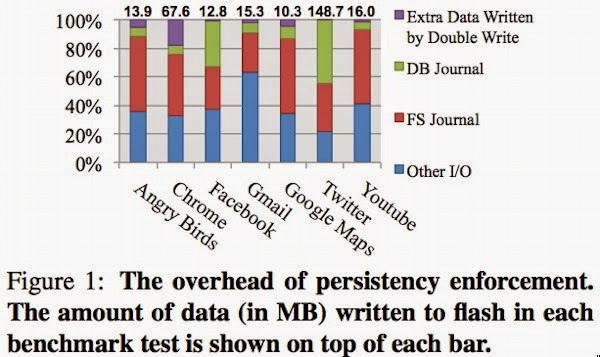If your cell phone has
non removable batteries, its DRAM memory can be treated as as a battery backed up
nonvolatile DRAM. This improve battery life time and speed of mobile devices
"data committed to flash was reduced by about 40 percent." See more
in the article below.
Actually, these
benefits should be achieved in any mobile device with an improved operating
system.
"several
innovations.
·
Quasi-NVRAM. They set aside a
portion of system DRAM to act as a battery backed up nonvolatile DRAM.
·
Device driver. A
new device driver and library that manage I/O between the qNVRAM and system
flash memory.
·
Persistent Page Cache. A
new data structure in SQLite using quasi-NVRAM to perform in-place updates to
the database files.
·
Relaxed data flushing. Absorbs
repeated writes to table files to further reduce I/O."
Ron
Insightful, timely, and accurate semiconductor consulting.
Semiconductor information and news at - http://www.maltiel-consulting.com/
Insightful, timely, and accurate semiconductor consulting.
Semiconductor information and news at - http://www.maltiel-consulting.com/
Summary: You still hear
complaints about nonremovable batteries in mobile devices – mostly Apple – but
there is an upside: the ability to eliminate performance overhead. Here's how.
By Robin Harris for Storage Bits | July 14,
2014 in
Three researchers, Hao
Luo, Lei Tian and Hong Jiang of the University of Nebraska, asked a simple and
seemingly obvious question. Since our mobile devices have non-removable
batteries why don't we treat DRAM as if it were nonvolatile?
Their paper, qNVRAM: quasi Non-Volatile RAM for Low Overhead PersistencyEnforcement in Smartphones was presented at the Usenix
HotStorage conference last month.
Background
Typically Android
mobile devices rely on SQLite, a shared preference key value store or the
filesystem API to save persistent data on local flash. These employ journaling
or file-level double-writes to ensure persistency.
The problem is that
these techniques require multiple writes to storage, incurring substantial
system overhead in devices that are already performance and power constrained.
For example, they
found that more than 75 percent of Twitter data was written for persistency
reasons. Looking at a group of common mobile apps they found that anywhere from
37 percent to 78 percent of the data writes were for atomicity. From the paper:
Courtesy
the authors.
Furthermore, it turns
out that Android kernel reliability — where these data structures reside — is
quite good, based on bug fixes and user support calls. They analyzed Android
issue reports and found that only 10 reports or 0.05 percent of all 19,670
reported issues related to Android defects with unexpected or random power-off.
That implies a small chance that unexpected power failure may occur.
The test
The researchers constructed a prototype test system with the with
several innovations.
·
Quasi-NVRAM. They
set aside a portion of system DRAM to act as a battery backed up nonvolatile
DRAM.
·
Device driver. A new
device driver and library that manage I/O between the qNVRAM and system flash
memory.
·
Persistent Page Cache. A new
data structure in SQLite using quasi-NVRAM to perform in-place updates to the
database files.
·
Relaxed data flushing. Absorbs
repeated writes to table files to further reduce I/O.
Results
Implemented on an Android
smartphone they found that
"...qNVRAM speeds up the insert, update and delete
transactions by up to 16.33x, 15.86x and 15.76x respectively."
The Storage Bits take Furthermore, the amount of data committed to flash was reduced by about 40 percent. Given how common constant feed updates are on mobile devices, this is a significant result.
Some are miffed that many
smartphones don't have easily removable batteries. This research shows the
upside of such designs: all DRAM can be treated as NVRAM whether on Android or
Apple's iOS.
Note that qNVRAM can't
replace flash. DRAM is more power-hungry and costly than flash.
But research shows that
by reducing the I/O overhead of the system with qNVRAM, significant gains in
performance — and presumably battery life — can be achieved at very little
cost. It also simplifies the problem of extending flash endurance.
It was obvious five years
ago with the advent of non-removable batteries on phones and notebooks that
engineers could take a new look at achieving persistency. Congratulations to
the researchers for taking a rigorous approach to the problem.


No comments:
Post a Comment